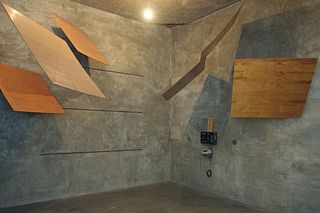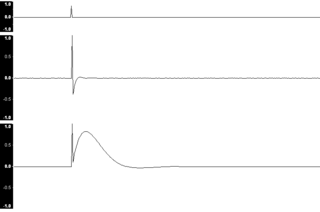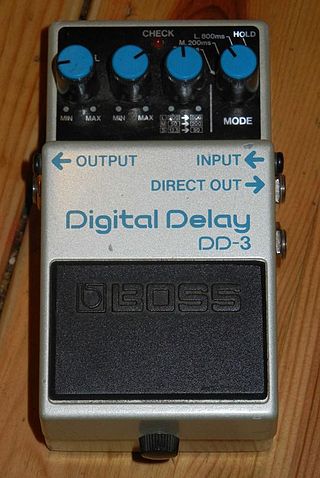
An effects unit, effects processor, or effects pedal is an electronic device that alters the sound of a musical instrument or other audio source through audio signal processing.
Reverberation, in acoustics, is a persistence of sound after it is produced. Reverberation is created when a sound or signal is reflected. This causes numerous reflections to build up and then decay as the sound is absorbed by the surfaces of objects in the space – which could include furniture, people, and air. This is most noticeable when the sound source stops but the reflections continue, their amplitude decreasing, until zero is reached.

A recording studio is a specialized facility for recording and mixing of instrumental or vocal musical performances, spoken words, and other sounds. They range in size from a small in-home project studio large enough to record a single singer-guitarist, to a large building with space for a full orchestra of 100 or more musicians. Ideally, both the recording and monitoring spaces are specially designed by an acoustician or audio engineer to achieve optimum acoustic properties.
A transducer is a device that converts energy from one form to another. Usually a transducer converts a signal in one form of energy to a signal in another. Transducers are often employed at the boundaries of automation, measurement, and control systems, where electrical signals are converted to and from other physical quantities. The process of converting one form of energy to another is known as transduction.

An echo chamber is a hollow enclosure used to produce reverberation, usually for recording purposes. A traditional echo chamber is covered in highly acoustically reflective surfaces. By using directional microphones pointed away from the speakers, echo capture is maximized. Some portions of the room can be moved to vary the room's decay time. Nowadays, effects units are more widely used to create such effects, but echo chambers are still used today, such as the famous echo chambers at Capitol Studios.

In signal processing and control theory, the impulse response, or impulse response function (IRF), of a dynamic system is its output when presented with a brief input signal, called an impulse (δ(t)). More generally, an impulse response is the reaction of any dynamic system in response to some external change. In both cases, the impulse response describes the reaction of the system as a function of time (or possibly as a function of some other independent variable that parameterizes the dynamic behavior of the system).
The precedence effect or law of the first wavefront is a binaural psychoacoustical effect concerning sound reflection and the perception of echoes. When two versions of the same sound presented are separated by a sufficiently short time delay, listeners perceive a single auditory event; its perceived spatial location is dominated by the location of the first-arriving sound. The lagging sound does also affect the perceived location; however, its effect is mostly suppressed by the first-arriving sound.

A sound reinforcement system is the combination of microphones, signal processors, amplifiers, and loudspeakers in enclosures all controlled by a mixing console that makes live or pre-recorded sounds louder and may also distribute those sounds to a larger or more distant audience. In many situations, a sound reinforcement system is also used to enhance or alter the sound of the sources on the stage, typically by using electronic effects, such as reverb, as opposed to simply amplifying the sources unaltered.
Morley Pedals is the name of a guitar effects pedal company, famous for manufacturing wah-wah pedals and other treadle type effects for guitar. Morley pedals use electro-optical circuitry rather than a potentiometer to control the effect. The foot treadle controls a shutter inside the pedal that in turn controls the amount of light reaching a photoresistor. The advantage to this system is that there are no potentiometers in the signal path to wear out and become "scratchy sounding" over time. Electro-optical circuitry is used throughout the classic Morley pedal line, which includes or has included volume pedals, delay pedals, chorus and phaser pedals, and many others.
Reverse echo and reverse reverb are sound effects created as the result of recording an echo or reverb effect of an audio recording played backwards. The original recording is then played forwards accompanied by the recording of the echoed or reverberated signal which now precedes the original signal. The process produces a swelling effect preceding and during playback.

Delay is an audio signal processing technique that records an input signal to a storage medium and then plays it back after a period of time. When the delayed playback is mixed with the live audio, it creates an echo-like effect, whereby the original audio is heard followed by the delayed audio. The delayed signal may be played back multiple times, or fed back into the recording, to create the sound of a repeating, decaying echo.
Gated reverb or gated ambience is an audio processing technique that combines strong reverb and a noise gate that cuts the tail of the reverb. The effect is typically applied to recordings of drums to make the hits sound powerful and "punchy" while keeping the overall mix clean and transparent sounding.

An analog delay line is a network of electrical components connected in cascade, where each individual element creates a time difference between its input and output. It operates on analog signals whose amplitude varies continuously. In the case of a periodic signal, the time difference can be described in terms of a change in the phase of the signal. One example of an analog delay line is a bucket-brigade device.
Elektromesstechnik (EMT) is a manufacturer of phonograph turntables and professional audio equipment, including a well-regarded line of artificial reverberation devices beginning with the EMT 140 plate reverb. The company was founded by Wilhelm Franz.
Acoustic enhancement is a subtle type of sound reinforcement system used to augment direct, reflected, or reverberant sound. While sound reinforcement systems are usually used to increase the sound level of the sound source, acoustic enhancement systems are typically used to increase the acoustic energy in the venue in a manner that is not noticed by the audience. The correctly installed systems replicate the desired acoustics of early reflections and reverberation from a room that is properly designed for acoustic music. An additional benefit of these systems is that the room acoustics can be changed or adjusted to be matched to the type of performance. The use of acoustic anhancement as electronic architecture offers a good solution for multi-use performance halls that need to be "dead" for amplified music, and are used occasionally for acoustic performances. These systems are often associated with acoustic sound sources like a chamber orchestra, symphony orchestra, or opera, but have also found acceptance in a variety of applications and venues that include rehearsal rooms, recording facilities conference rooms, sound stages, sports arenas, and outdoor venues.
Musical outboard equipment or outboard gear is used to process or alter a sound signal separately from functionality provided within a mixing console or a digital audio workstation. Outboard effects units can be used either during a live performance or in the recording studio.
3D sound reconstruction is the application of reconstruction techniques to 3D sound localization technology. These methods of reconstructing three-dimensional sound are used to recreate sounds to match natural environments and provide spatial cues of the sound source. They also see applications in creating 3D visualizations on a sound field to include physical aspects of sound waves including direction, pressure, and intensity. This technology is used in entertainment to reproduce a live performance through computer speakers. The technology is also used in military applications to determine location of sound sources. Reconstructing sound fields is also applicable to medical imaging to measure points in ultrasound.
3D sound is most commonly defined as the daily human experience of sounds. The sounds arrive to the ears from every direction and varying distances, which contribute to the three-dimensional aural image humans hear. Scientists and engineers who work with 3D sound work to accurately synthesize the complexity of real-world sounds.
Dereverberation is the process by which the effects of reverberation are removed from sound, after such reverberant sound has been picked up by microphones. Dereverberation is a subtopic of acoustic digital signal processing and is most commonly applied to speech but also has relevance in some aspects of music processing. Dereverberation of audio is a corresponding function to blind deconvolution of images, although the techniques used are usually very different. Reverberation itself is caused by sound reflections in a room and is quantified by the room reverberation time and the direct-to-reverberant ratio. The effect of dereverberation is to increase the direct-to-reverberant ratio so that the sound is perceived as closer and clearer.
ValhallaDSP is a company and brand name for multiple digital reverberator and delay plugins for Macintosh and Windows computers made by Sean Costello.










